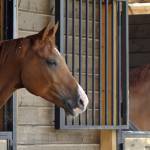Keeping Your Horse Content on Stall Rest

Your horse has a serious injury or is recovering from surgery. The veterinarian says, “Stall rest for the next four weeks.” Because your horse has always been pastured for a good part of every day, you immediately wonder whether the horse, and you, will make it through this period of enforced idleness.
Though many horses get along fine living in a stall almost all the time, most horses thrive on some turnout, free exercise, and spending time with their pasturemates. Taking away these important elements is stressful! If you have to treat an injury, change dressings, give injections, or administer oral medications, the stress level can go way up for both horse and owner. Try these tips to make the time a little more pleasant for both of you.
Stall rest doesn’t have to mean solitary confinement. If your horse must stay in a stall while the other horses are turned out, choose another quiet horse to stay in the barn at least part of the day to keep him company. This horse should be kept where the confined horse can see it, either in a neighboring stall or across the barn aisle. It doesn’t have to be the same horse all day or every day; changing the companion at midday is fine (bring in the afternoon horse before turning the morning horse out).
Consider getting a special pal for your confined horse. A goat, sheep, or small pony might be the perfect choice to share the invalid’s stall or paddock for a few weeks. Check out this idea with your vet, and keep an eye on the arrangement for the first few days. You don’t want your horse to be too active. A pal should not be a playmate, but it can provide companionship and keep the injured horse from getting anxious and pacing the stall.
Being on stall rest may not mean the horse has to stay inside the barn all the time. Ask the veterinarian how soon the horse can be kept in a tiny outdoor paddock or in a temporary round pen made of gates fastened securely together. If you can move the temporary pen every day, the horse can get some fresh grass and stay in sight of his equine friends.
If stall rest really has to mean staying inside, take your individual horse’s temperament and behavior into consideration as you choose the location of his stall. Is he likely to get upset when the other horses are led in and out for turnout or training? If so, a quiet corner stall away from the door might be best. However, if you have a horse that can stay relaxed while showing an interest in what’s happening, he might be happier in a location where he can watch people and horses coming and going. A stall with a window will be a good choice for some horses, while others will stay calmer in a stall with solid walls.
Adding stall toys or a mirror (unbreakable, securely mounted) may give the horse a way to fill his time. His feed will probably be reduced considerably because his work load has been cut back, but he’ll still get hay, and picking through it will provide some interest. Consider getting a slow-feeder hay net or tub; these devices restrict access so that the horse has to nibble a bit at a time rather than taking large mouthfuls of hay. Eating hay from a slow-feeder will keep the horse occupied and will also introduce a continual supply of hay to the stomach, helping to prevent gastric ulcers.
Try to spend extra time with your horse while he’s on stall rest. Talking to him, grooming him, combing out his mane and tail, and scratching him all over are activities that will help alleviate boredom. Use common sense when you visit: your horse will probably have a bit more energy than usual, at least in the first few days of stall confinement, so keep an eye on him and watch for sudden movements and playful behavior. For a very active and fit horse suddenly placed on stall rest, it may be safer to do some of your visiting from outside the stall until he settles into a routine.
Though many horses adapt surprisingly well to stall rest, others simply can’t seem to relax. Horses that endlessly pace, paw, or circle the stall are a danger to themselves and their handlers. For these individuals, consult the veterinarian about the use of mild sedatives as needed.
A final note of caution: Before leaving a horse in a stall for long periods of time, do a very careful inspection of the stall and correct any defects. Are lights completely out of reach or protected by steel cages? Is the floor dry and level? Are windows in good repair and protected by a grate the horse can’t break? Is the door rolling or swinging smoothly? Is the latch in good condition and out of the horse’s reach? Is there space under the door or walls where a horse could catch a leg when he’s lying down? Are there loose, broken, rough, or splintered boards anywhere in the stall? Is the feeder solidly mounted and free from rough or sharp edges? Is the water bucket secure, safe, and adequate for your horse’s needs? Do you need to add a second bucket to bring 24-hour capacity to at least 10 to 12 gallons? A quick look around the stall isn’t enough; your horse will soon have nothing to do but find the dangerous feature you didn’t notice, so make a thorough examination and fix any problems you find.








